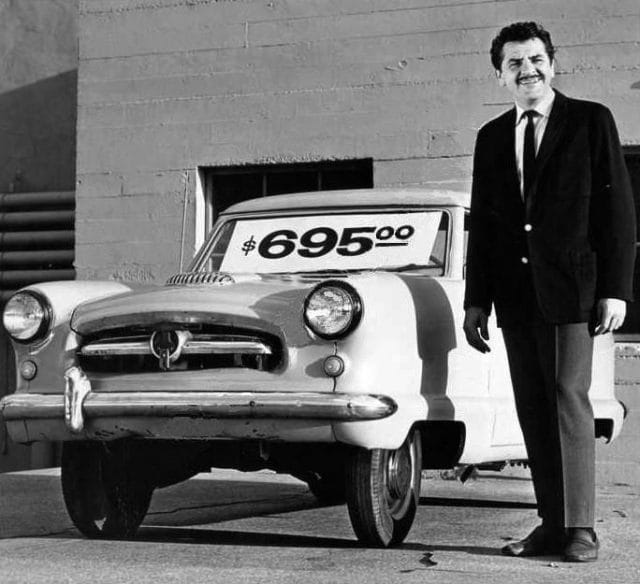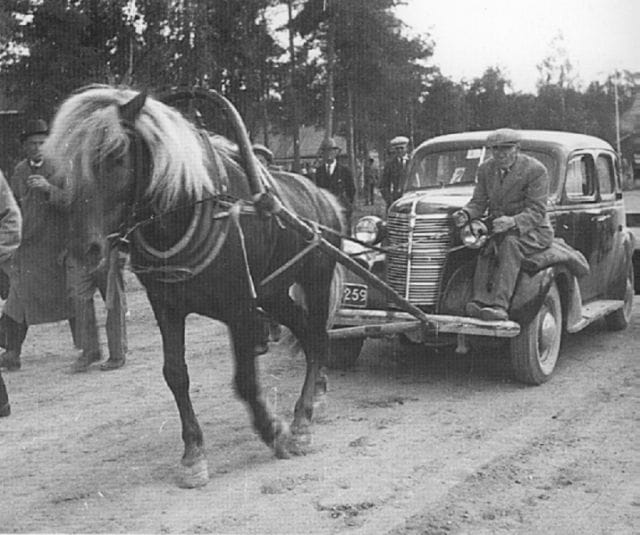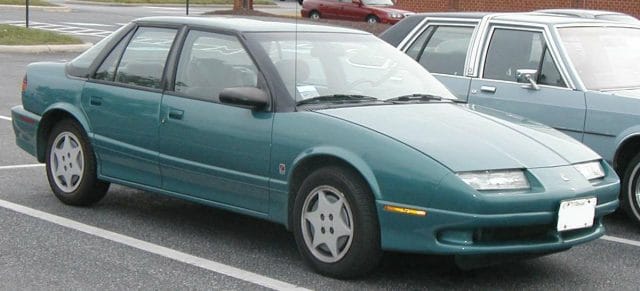Even if you’ve never purchased a car, you know the script. You stroll onto the car lot feigning indifference. The salesman sizes you up and asks what you’re looking for. You point to a red sedan. And then the dance begins.
While most of our day-to-day transactions revolve around fixed, unambiguous prices, purchasing a car remains a glaring (and for some of us, excruciating) exception. Low-balling and brinkmanship are not skills that the typical American cultivates for daily use, and yet we are all expected to employ them when we make one of our largest lifetime purchases. Haggling over the price of a car is as American as apple pie—except most people actually like apple pie.
Irritating though it may be, the process of buying a car is also a genuine economic curiosity. Hard bargaining has gone the way of the abacus in most economic spheres. To the extent that we find ourselves bargaining in other settings—after calling to cancel our cable subscription, when requesting add-ons at a hotel, or when purchasing a house—the back-and-forth is usually indirect, either passed through an intermediary or expressed under the guise of “special rates” and discounts.
But the process of haggling for a car sticks around like a vestigial tail. What makes the car sale unique? And why, in the age of consumer protection regulations and online retail, won’t this economic anachronism go away?
The answer begins with the predecessor to the car — the horse.
From Horses to Horsepower
There is an undeniable cultural component to the way that we transact with one another. Anyone who has spent much time outside North America or Western Europe is likely familiar with the process of shopping untethered from the world of posted prices. For those who are unaccustomed to hard bargaining, haggling can not only feel foreign, but like a violation of well established social norms.
As the anthropologist Gretchen Herrmann wrote of American consumer culture in 2003, “there is a circumscribed range of culturally tolerated bargaining behavior and those who transgress these boundaries may be viewed as aggressive, self-serving, and even greedy.” We do not like to think of ourselves in a zero-sum contest with our friendly neighborhood grocer.
Clearly, car culture is unique. The auto retail industry is largely isolated from other commercial enterprises and so its strange folkways are shaped by its own peculiar history. In other words, the horse-trading mentality defines that car market because the horse-trading mentality has always defined it. In fact, according to historian Steven M. Gelber, horse-trading (that is, the literal trading of horses) may be a direct antecedent to auto dealing.
It all starts with the concept of the “trade-in,” he explains in his book, Horse Trading in the Age of Cars: Men in the Marketplace. “The process of swapping an old ride for a new one and making up the difference in their values with a cash payment was an established practice in horse trading,” he writes. “Car buyers demanded that car sellers continue that tradition by accepting their old vehicles as partial payment for new ones.”
Even if those new cars came affixed with price tags, the trade-in introduced unavoidable uncertainty into the transaction. As the adage suggests, the horse-traders of old would inspect the teeth of prospect horses in order to estimate its value. Likewise, the 20th century’s car dealer kicks the proverbial tires. Absent real certainty over the value of the total transaction, the price was suddenly up for debate.
The explosion of the international automobile market in the second half of the 20th century saw the practice exported to countries across the globe. Nowadays, customers the world over get to experience the distinct joys of haggling for a good deal on a car.
No Time to Haggle
Economists have a term for the “it is because it was” argument advanced by Gelber: path dependence. A century ago, a horse-dealer made the transition into the burgeoning car industry and brought with him the art of the haggle. The industry has been in that economic and cultural groove ever since.
Even car customers’ expectations play a role in maintaining this status quo, says Preyas Desai, a professor of business administration at the Fuqua School of Business at Duke University. “This institution has existed for such a long time that customers expect to haggle when they go to a car dealership, even though they might hate it,” he says. “If I go to a dealership and I don’t haggle, then I feel like I’m not doing my job.” Even worse, you might feel like you’re getting screwed.
Still, though cultural practices often outlast their practical usefulness, it’s hard to imagine such a time-consuming and unpopular practice surviving in the dog-eat-dog car retail industry without any apparent economic justification.
It certainly hasn’t survived in most other spheres.
Fixed prices may seem like a permanent fixture of commercial life, but, as a 2015 episode of NPR’s Planet Money explained, the price tag is a relatively new phenomenon. As the consumer economy began to expand at the turn of the 20th century, the costs of bargaining started to add up for businesses. Tracking inventory, paying sales taxes, and ensuring that each of your clerks is a skilled negotiator are significant burdens in a price-negotiable world.
Haggling is just too time consuming for most sectors of the modern economy. If you think it takes a long time to get in and out of Costco on a Sunday afternoon, just imagine if the price of each of your jumbo packs of toilet paper was suddenly up for debate.
Every Car Sale a Special Snowflake
But cars are not like rolls of toilet paper.
For one, a car is a big-ticket item. While it might not be worth the hassle to argue over the price of lettuce, on the auto lot, thousands of dollars in savings separate the good hagglers from the bad. “It looks kind of awkward to negotiate over the little things, but also from the seller’s perspective, there’s a transaction cost,” says Desai. For seller and buyer alike, “that cost is justifiable if the price is high.”
Cars are also unexpectedly idiosyncratic products. First, there are the obvious differences between each make and model. Trade-in agreements complicate things further. Finally, there are trim and design features, add-ons, warranties, post-sale services, and finance options to consider. Add it all together and you have yourself a bespoke product.
Plus, there’s always that TruCoat.
Car customers come in different makes and models too. Budget, priorities, safety concerns, family size, and access to public transportation are only some of the factors that make each would-be buyer a distinct business prospect from the perspective of a dealer. While few people would debate the acceptable price range of a cup of coffee, a bright red Camaro with a spoiler and a coffee-can muffler is an acquired taste. Willingness to pay will vary accordingly.
Price uncertainty is exacerbated by changes in cyclical buying patterns (April through September is peak car season), along with relatively minute variations in local supply. In any given region, the number of people actively looking to purchase a car is relatively small. In such a market, a single dealer’s decision over whether or not to purchase another yellow Honda Fit can have a dramatic effect on the local price across the region. Given all of this variation, a flexible pricing system (that is, haggling) gives the dealer much more flexibility.
In 1958, Congress passed the Automobile Information Disclosure Act, which required all car dealers to place a sticker featuring the manufacturer’s suggested retail price in the window of each car. It was an attempt by the federal government to instill a semblance of predictability and fairness in the auto market, but it hardly put an end to haggling. Nowadays, conventional wisdom holds that only suckers pay the list price in the window. Instead, discerning customers use it as the ceiling and a jumping off point in a lengthy negotiation.
The Unexpected Savings of Haggling
In 2004, Duke’s Preyas Desai and his Fuqua school colleague Devavrat Purohit wrote an article in which they modeled how consumers and producers might interact in a competitive market made up of haggle-friendly and fixed-price firms. Their findings, explains Desai, were counter-intuitive: “When there are a lot of consumers in the marketplace that don’t like haggling, then we are actually more likely to see haggling.”
In other words, haggling may exist not despite consumer dissatisfaction with the practice, but because of it.
The logic goes like this: if a market is composed largely of shrewd buyers who enjoy the practice of one-on-one price discovery, it stands to reason that they will enjoy haggling largely because they are good at it. If that is the case, firms will face little incentive to offer negotiable prices, since the majority of their customers will take them to the cleaners. “On the other hand,” says Desai, “let’s say 80% of the market is made up of people who are not good hagglers and 20% are people who are good hagglers—then the seller only has to give discounts to 20% and [can] charge a relatively high price to everyone else.” In a world in which most customers loathe haggling, the suckers subsidize the savvy.
But even if the process allows car dealers to truly bilk the occasional customer, there is also reason to believe that haggling actually allows car dealers to offer lower prices on average.
Consider your average car lot, explains Henry Schneider at the Smith School of Business at Queen’s University. Space is limited, so each car occupies real estate that could otherwise be used to sell another vehicle. In the meantime, the dealer has likely purchased the car on credit, and those interest costs are mounting. The car itself, which was a brand new model a few months ago, is rapidly becoming less new and thus, less valuable.
“The manufacturer may send the dealer a second red Nissan Sentra, which the dealer would want to move quickly because there is a cost of carrying inventory,” says Schneider. “So the price the dealer is targeting for a particular car may vary daily or weekly. Bargaining may be an easier price-setting mechanism than changing a posted price every day or week.” Plus, if a customer walks in offering to pay a hair below the list price, the dealer may actually come out ahead by cutting a deal and saving on the inventory cost. In theory, says Schneider, these inventory cost savings could allow haggle-friendly dealers to offer lower average prices than fixed-price competitors.

Photo credit: Tino Rossini
This appears to have happened in Canada in the early 2000s. Toyota, responding to corporate focus group findings that less than one in five Canadians enjoyed haggling over car prices, rolled out its “Access Toyota” initiative, a national fixed price program. According to a 2008 study of the program conducted by economists at the City University of Hong Kong and the University of British Columbia, the prices of vehicles sold under the haggle-free program were 2% higher on average than comparable vehicles that were sold via old fashioned price negotiation.
While Access Toyota’s higher prices might reflect the costs of slower inventory turnover, the authors of the study offer another somewhat simpler explanation: customers who don’t like haggling are willing to pay a little bit more not to do it.
A Haggle-Free Future?
Toyota Canada is not the first company to dispense with negotiable car prices. The defunct car company, Saturn, was the first major brand to boast “no haggle” prices in the early 1990s, a move which helped trigger a trend of independent dealers employing similar strategies. According the historian Steven Gelber, Saturn’s new approach was particularly popular with women and customers of color, who often distrusted the Glengarry Glen Ross-style of traditional car salesmen.
Around the same time, CarMax opened its first lot in the suburbs of Richmond, Virginia. A Circuit City spin-off, the car retail company, which primarily focuses on the used market, has outlived its parent corporation partly due to the success of its no haggle policy. And yet, two decades after both Saturn and CarMax helped to popularize the practice, no haggle remains the exception to the rule. Saturn has gone out of business (though there isn’t any evidence that this was the result of its pricing policy). And while CarMax is now the largest car retail company in the country, they control less than 2% of the used auto market. Haggling for a car still remains the norm.
The Internet may ultimately pose the largest threat yet to the unchecked reign of haggledom. Customers not only have access to a wider array of price comparison options online, new online services such as Beepi explicitly advertise their negotiation-free buying model.
The advent of online car shopping may be especially good news for shoppers who are typically disadvantaged by the negotiable price model. A 2002 study conducted by economists at Yale, UC Berkeley, and UCLA found that black and hispanic customers typically paid a “minority premium” at the car lot, even when controlling for differences in income, education, and willingness to shop around. When the researchers turned to data from online car shopping, they found that the price gap had almost entirely disappeared.
And then there’s Tesla. The electric car company has ruffled many an industry feather both by selling cars directly to customers online and by adhering to a fixed price system. In fact, these two novelties are related. A customer who wants to purchase a Model S does not have the option to shop around and play dealers off one another. Each Tesla comes directly from Tesla, and so the price is of the take-it-or-leave-it variety.
Even so, Tesla may be a special case, says Queen’s University’s Henry Schneider. Given the popularity of Elon Musk’s electric car, the company has faced capacity constraints and lengthy customer backorders. In this situation, says Schneider, “price discrimination may be less necessary, because Tesla is already selling all the cars it can make. In this scenario, Tesla might become interested in haggling once it can expand its production.”
Then again, it’s also possible that the company’s pricing model serves an important marketing function. For some, haggling evokes the image of sleazy car salesmen in a cheap suit. “Perhaps the distaste of haggling is inconsistent with the Tesla, high-end brand,” says Schneider.
If, as a result of Tesla’s success, consumers associate the fixed pricing model with car quality, this could have a significant impact on the industry. Consumer expectations, says Preyas Desai from Duke University, are all important.
Desai speaks from experience. A few years ago, he decided to buy a Lexus. The process was short and sweet: he went online, found a price reference, called up a dealer and made an offer. Sure, with a little more time and cunning, the professor could have lowballed the salesperson and gotten himself a sweeter deal. But he says he opted for the simpler approach.
“I do research in haggling and I know a lot about the auto market and all of that,” he says. “But I just did not want to engage in all of that nonsense.”
Our next article explores the 100-year history of celebrity pets—and how cuddly pugs become cash machines. To get notified when we post it → join our email list.
![]()
Want to write for Priceonomics? We are looking for freelance contributors.






